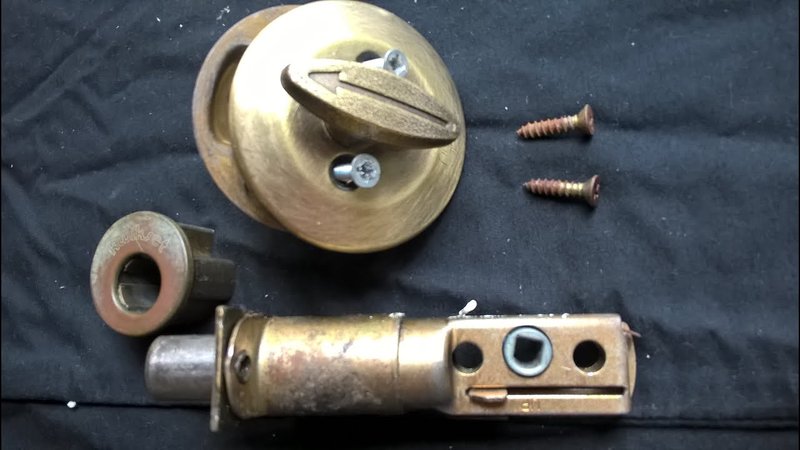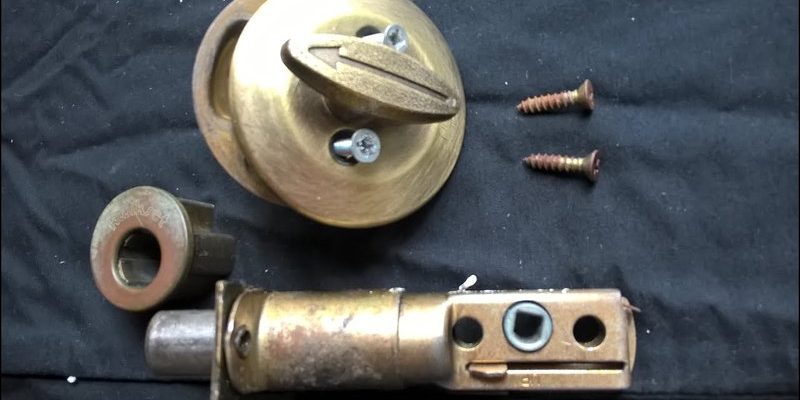
Honestly, repairing a damaged deadbolt cylinder isn’t rocket science, but it does require some know-how, a few tools, and a good sense of when to admit defeat and swap it out for a new one. You might be wondering: Can you save your lock, or is it time to call it quits and start fresh? Let’s break it down so you can keep your doors secure and your day running smoothly.
What Causes Deadbolt Cylinders To Fail?
Deadbolt cylinders aren’t invincible—they battle everyday wear, grit, weather, and sometimes even bad luck. The most common culprit is simple wear and tear. Over the years, keys grind against the pins inside the cylinder, causing them to wear down or stick. That’s especially true for popular brands like Yale, Kwikset, or Schlage, which millions of people use daily.
Another big reason? Dirt and debris. If dust, lint, or even a tiny piece of a broken key get inside the cylinder, it can jam the mechanism. People sometimes try to force the lock, which just makes things worse, bending pins or breaking springs inside. Let’s not forget about weather—outdoor locks get hammered by rain, ice, and sun, which all play a part in corrosion and rust.
Sometimes, the real villain is a quick DIY job or an old door that’s slightly out of alignment. If the bolt doesn’t fit cleanly into the strike plate, the extra force each time you lock or unlock it eventually takes a toll on the cylinder. In rare cases, someone trying to break in might damage the lock by force or with a tool. All of these issues can cause your deadbolt to feel stubborn or fail altogether.
Signs Your Deadbolt Cylinder Is Damaged
Let me share a quick story. I had a friend who kept blaming her old key for sticking in her deadbolt—she tried graphite powder, WD-40, and even a toothbrush, but the lock just wouldn’t cooperate. Here’s the thing: the problem often isn’t the key, but a failing cylinder. If you’re noticing these signs, your deadbolt cylinder might be waving a white flag:
- The key is hard to insert or pull out—doesn’t matter how new or clean it is.
- You have to jiggle the key just to get the lock to turn (or it won’t turn at all).
- The lock feels loose or wobbly, even after tightening the screws on the faceplate.
- The deadbolt won’t fully extend or retract with the key or thumbturn.
- Visible damage like cracks, dents, or corrosion around the keyhole.
If you’re running into one or more of those, your deadbolt cylinder is probably overdue for some care—or a replacement.
How To Repair A Damaged Deadbolt Cylinder
Here’s where things get hands-on. If you’re feeling handy and your cylinder isn’t totally destroyed, a basic repair might do the trick. First, let’s talk tools: you’ll typically need a Phillips screwdriver, needle-nose pliers, a can of compressed air, and maybe some spray lubricant (stick to lock-specific ones—avoid heavy oils that gum up the works).
Start by removing the lock from your door. Most deadbolts have two screws on the interior side; unscrew those and the cylinder should come free. Gently tap out the cylinder from the housing. Now you can see inside—use compressed air to blow out dust or debris. If you spot a bent pin or spring, you can sometimes reset or gently realign it with the pliers. Mist the inside lightly with lubricant if it looks dry, then work the key in and out a few times to sync the cylinder’s pins.
If you have a lock code or rekeying kit (especially for Schlage or Kwikset), you might be able to reset the pin sequence—follow the manufacturer’s instructions, as every brand is a bit different. Clean up any obvious corrosion with a bit of rubbing alcohol on a cotton swab. Once everything looks smooth, reassemble the lock and test it before reinstalling the cylinder in your door.
When Should You Replace a Deadbolt Cylinder?
Knowing when to throw in the towel is important. Sometimes, repair just isn’t worth the trouble—or it isn’t safe. If you notice serious damage, like a cracked or split cylinder housing, heavy rust, or missing internal parts, replacement is always the right move. This is especially true if the cylinder won’t hold a new code or if the pins won’t reset, no matter how hard you try.
Another red flag: if someone tried to break in and damaged the lock, or if you’ve lost a key and worry about security. Even if you manage to get the lock working again, your sense of safety is worth the cost of a new cylinder. Most deadbolts are affordable and designed to be replaced as a whole unit, especially for common brands you’ll find at any hardware store.
In situations where your lock keeps causing problems, even after you clean and reset it, it’s probably time to replace the cylinder. Honestly, a new lock usually comes with clear pairing and syncing instructions, fresh pins, and updated security features. It’s a small investment for peace of mind.
Step-By-Step: How To Replace A Deadbolt Cylinder
Let me walk you through it—no locksmith required if you’re comfortable with a screwdriver. Here’s what you need to do:
- Remove the old deadbolt: Open your door. On the inside, you’ll see two long screws holding the interior plate to the exterior. Unscrew them and gently pull both sides free.
- Take out the cylinder: Once the plates are off, the cylinder should slide out. If it’s stuck, check for small set screws or retainer clips on the inside.
- Install the new cylinder: Slide the new one in, making sure the cam (the flat bar in the middle) lines up with the latch mechanism.
- Reattach the plates and screws: Tighten them by hand, making sure everything feels snug but not forced. Test the key and thumbturn before fully tightening.
Swap the old keys for new ones that came with the deadbolt, and you’re all set. Some universal deadbolts let you rekey the cylinder to match your old keys, but for most people, a fresh start works best.
Repair Vs. Replacement: Which Is Better?
You might be wondering, should you try to save the old lock or just buy a new one? Here’s my take: repair is a good option if the damage is minor—maybe there’s some gunk inside or a pin is slightly misaligned. It’s cheap, quick, and keeps your original hardware. But if the lock is still giving you trouble after troubleshooting, or if it’s been compromised by force or age, replacing the deadbolt is the smarter move.
Modern deadbolts—even basic Defiant or Kwikset models—are more secure than those made ten or fifteen years ago. They often have better sync with smart home security, coded key systems, and even upgraded anti-pick features. If you’re relying on your deadbolt for daily security, it’s worth getting something you can trust. Universal replacement kits make the switch painless, and you don’t have to spend hours trying to reset broken pins or code new keys.
Replacement is especially important if you share your home with kids, roommates, or anyone who values smooth, reliable access. It’s like swapping out an old phone battery—it’s possible to squeeze a little more life out of the old one, but a fresh start is often easier and safer in the long run.
Tips For Keeping Your Deadbolt Cylinder Healthy
Deadbolt cylinders don’t ask for much, but a little care goes a long way. Every few months, give yours a quick inspection. Gently clean around the keyhole with a small brush or compressed air. Use a proper lock lubricant or graphite powder—never WD-40 or oil, which can attract more dust.
If you swap out batteries in any smart lock or electronic deadbolt, check the cylinder while you’re at it. Look for signs of rust or wobbly hardware, and make sure the door and strike plate are still aligned. Don’t force the key if it feels stuck; that’s a clear signal something’s wrong inside.
If you’ve bought a universal or brand-specific deadbolt, keep the instructions handy in case you need to reset, code, or pair new keys. And if you ever lose a key or notice the lock acting up, address it quickly rather than waiting until you’re locked out at midnight.
Don’t wait for a crisis to show your deadbolt a little love—regular checks and quick fixes can save you time, money, and a lot of hassle down the road.
Final Thoughts: Keeping Your Home Secure Starts At The Lock
Repairing a damaged deadbolt cylinder is about more than just fixing a stubborn lock—it’s about protecting your home and giving yourself peace of mind. Whether you’re troubleshooting a minor jam or swapping out a worn-out cylinder for a shiny new one, knowing what to look for (and when to replace) keeps your door secure and your day stress-free.
If you’re not sure which way to go, don’t be afraid to start with a quick repair. But remember, safety always wins; when in doubt, a brand-new deadbolt is a small price to pay for a secure home. With a few simple tools and a little patience, you’ll have your door working smoothly in no time—and you can get back to living your life, without wrestling with your keys at the door.
